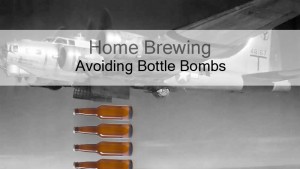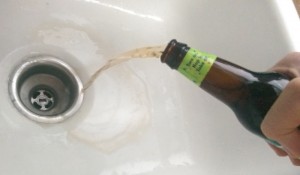
What Is Cold Crashing?
Cold Crashing is the process of rapidly dropping the temperature of your home brewed beer before carbonation. This is done to have yeast, proteins and other solids fall out of suspension resulting in a clearer beer and removing or reducing chill haze.
How Does Cold Crashing Work?
The cold temperatures encourage yeast to clump together and hibernate. As these clumps gain weight they naturally sink. The cold also causes proteins to bind with polyphenols also dropping out of solution with the added weight. It is the yeast and proteins that cause cloudy and chill hazed home brews.
When Should I Cold Crash?
Sometime after final gravity is reached but before you carbonate. Generally, cold crashing is the final step before bottling so cold crash when you would otherwise bottle/keg your beer. If you cold crash too early you could stop the yeast from cleaning some fermentation byproducts like diacetyl, waiting a week after FG is reached before Cold Crashing should be plenty of time to avoid that predicament.
Dry Hop Before Or After Cold Crash?
Save the dry hopping for after you cold crash. When you have let the beer sit cold for the desired amount of time, bring it back up to fermentation temperature. Colder temperatures aren’t conducive for dry hopping and with less yeast in suspension, after the cold crash, there will be less yeast interaction with the hops. Changing the temperature of your beer won’t hurt the flavor but don’t expose it to light or oxygen for too long.
Can I Dry Hop Before I Cold Crash Anyways?
Sure, it just isn’t optimal because of the hops natural interactions with the large amount of yeast in solution and you generally would want to dry hop as close to bottling as possible to preserve the fresh aromas. Your beer will still turn out fine. Just don’t cold crash during your dry hop, it just doesn’t work at cold temperatures.
What Is The Difference Between Cold Crashing And Lagering?
Though a similar process, Cold Crashing is only done for clarifying beer. Lagering is a conditioning process that is done to brew a specific style of beer. With lagering, the beer is stored cold for extended periods of time with specific yeasts to reach a specific flavor profile. Cold crashing is done only to make clearer beer without changing the taste.
What Temperature Should I Go With?
Cold. This varies depending on who you ask. I usually cold crash at 40F which is just cold enough to put ale yeast into hibernation and begin to clump. Some go much colder to just above freezing. Somewhere in that range would be just fine with colder temperatures perhaps working quicker or better for long term storage. Be careful setting it too low, as the variance on the temperature controller could cause your beer to freeze.
How Long Should I Cold Crash For?
Some report success going with times as short as 24 hours, others have left their beers for 6+ months. It all depends on your timelines and goals. At 40F I will leave my beers, generally for around a week and have found that effective. If your goal is crystal clear beer, a month should be plenty of time to achieve that. The amount of time necessary depends on the flocculation rate of the yeast used, with higher rates clearing more quickly as well as lower temperatures.
Do I Need To Re-pitch Yeast When Bottling?
No. Plenty of yeast will remain in suspension even after months in cold storage. That said, it couldn’t hurt to add some dry yeast if you are worried about getting quick carbonation. You can add a small amount to each bottle or add directly to the wort after it is back at fermentation temperature and that may help speed things up. It will generally take longer to carbonate a cold crashed beer so keep that in mind for your schedule.
Does Cold Crashing Change Priming Sugar Amounts?
There is no reason to alter the amount of priming sugar based on the temperature of your beer. Though it is true that the volume of dissolved CO2 varies with temperature, the difference is such a small amount that for the brewers purposes it can be considered none. Proceed as you normally would. You can let the beer get back up to temperature or bottle cold.
Can I Cold Crash In Primary Or Should I Move To A Secondary?
Either method is fine. Go with what you are more comfortable with and what the size of your temperature controlled area and brew schedule will allow.
What should I Do With The Airlock?
It is possible with the airlock left on you will have some liquid suck into the fermentation vessel when cold crashing. To avoid this, the airlock can be removed while cold crashing and put back on after reaching temperature. This can expose your beer to infection but at its fermented state, infection will be unlikely, just cover the airlock hole with some sanitized aluminium foil or other sanitized item to protect against solids or insects getting in. Best practices would be to use a stopper, cutting off all air from entering.
Can I Cold Crash After Bottling/Kegging?
Sure, the sediment just falls out of solution to the bottom of the bottle or keg. You may have noticed this already in your home brews. Cold crashing beforehand will help reduce this sediment. Just store cold and don’t disturb for a week or longer. Store bottles upright and try not to disturb the sediment when you pour. Be sure your beer is fully carbonated before going to cold storage or you may end up with flat beer.
Ask your question about Cold Crashing in the comments below.








Thanks for the info, though I would have to disagree on a couple points. First, cold crashing for 48 hours is sufficient at around 33-36 depending on the gravity, and when dry hopping, you absolutely want to dry hop before you cold crash, otherwise, raising the temp back up and then dry hopping defeats the purpose since you’ll have all sorts of hop residue that didn’t sync back down, and when you rack it out, you’ll pull all that with you. Better to dry hop, the cold crash, then while it’s still cold, rack it out so most of the sediment remains at the bottom of your fermenter. The amount of aroma lost is minimal with the cold crash compared to the advantage of a clearer beer.
Also, I would never recommend taking off the airlock when cold crashing, that defeats the purpose of the “air”lock since now, when you lower the temps, you will absolutely bring in air from the outside (presumably from the fridge) as it sucks into your beer and oxidizes it. Still a potential for infection, but I’d be more worried about oxidation. Just leave a little vodka in your air lock so that if any liquid does get sucked in, it’s just a little alcohol. 🙂
Cheers though, thanks for posting that info!
Thanks Paul for sharing your process, some good points you raise. I agree with you that the timing of the cold crash is going to depend on that specific beer. Opinions are going to vary as far as time and temperature.
If your not going to dry hop using a bag, then yea go ahead and dry hop first and then do a short cold crash. Still, for the best hop utilization and aroma dry hopping should be done after a cold crash when the beer has gotten back up to temperature. Dry hopping should always be the last step, when possible and done at the right temperature.
I recommend a stopper. Without a plug for the hole, removing the airlock for a short time and covering isn’t best practices but the risk of oxidation is extremely low due to the layer of co2 covering the beer.
Using an alcohol in the airlock is fine in theory but air will still get in if the temperature is dropped too quickly and all of the alcohol is sucked in with it, defeating the purpose, so why get anything not intended in the beer?
Thanks again for sharing your experience with cold crashing!
Actually hadn’t considered a stopper with no hole. That would be ideal for sure. I was just saying that recommending foil to cover the hole would be more scary (to me anyway) than using the airlock. At least then you risk less the chance of oxidation. But the stopper without the hole is a great idea! I’m cold crashing a DIPA as we speak so I’ll monitor the airlock I’m using and see if it sucks all the vodka in and report back. Good point there.
For when to dry hop, I get what you’re saying too. Even with the hop bag, there’s still sediment, and since I keg now (so much easier), it makes the most sense to me to dry hop for 5 days, cold crash for two and right into the keg to help carbanate faster since it’s already at near freezing temps. I’ve heard you do lose a little hop aroma, but not much. We’ll see how this one turns out. Thanks for the response back! You’re right though, there are varying opinions and it does come down to personal choice. Thanks again!
Right on, I get what your saying. Always fun to talk homebrew. Thanks for stopping by!
I use the three piece airlock and I always empty it and put it back together! Nothing can fall or get sucked in, works great.
I will be dry hopping and cold crashing an IPA for the first time. I have a 60l fermenter. I had a 10 gallon batch that I racked from primary into two 5 gallon corny kegs and dry hopped. My plan was after 10 Days, currently on day 5, to cold crash and then rack to serving. What are your thoughts on this? What temperature and how long? I have a 15 cubic ft chest freezer with a Thermostar temp controller. Should I have cold crashed in the fermenter, then secondary, dry hop then serving? Thanks for the advice!
I have always dry hopped then cold crash but I am reading more and more recommendations such as yourself to dry hop after then do a bit of a cold crash again.
I have a Pale Ale brewing now I’m gonna try your way and see if the hopness is better. I always rack to a bottling bucket with one of those reuseable coffee filters in a funnel so I don’t get any little debris in final product so I should be good.
Great post by the way.
Cory
Hey thanks dude. There is certainly a debate about if the loss in efficiency is worth the trouble to do it that way but the yeast definitely has an interaction with the hops and the temperature drop definitely lowers the overall hoppy-ness (for lack of a better word) but not so dramatically that all people find it necessary. Just a sort of best practices thing.
Re’ the question of dry-hopping before/during/after cold crashing.
My understanding is that organic aroma & flavour compounds (in the lupulin) are soluble in the alcohol that is produced during fermentation and that this solubility is independent if temperature. I also understood that importing those compounds into the beer (via solubility in alc.) during dry-hopping was independent of yeast function.
The word “lager’ is taken from a German word meaning “to store.” Lagering is allowing your beer to sit in storage, be it before or after fermentation.
While a “lager” IS a style of beer, the process of lagering is technically also used on aged ales. A bourbon barrel aged stout is an ale that has essentially been “lagered” in a repurposed barrel.